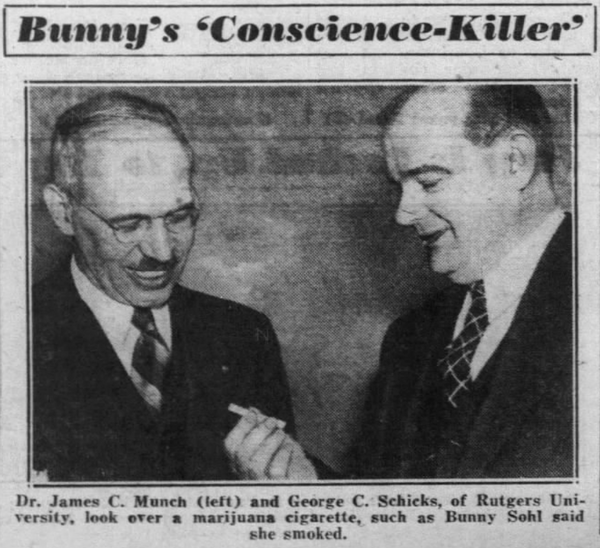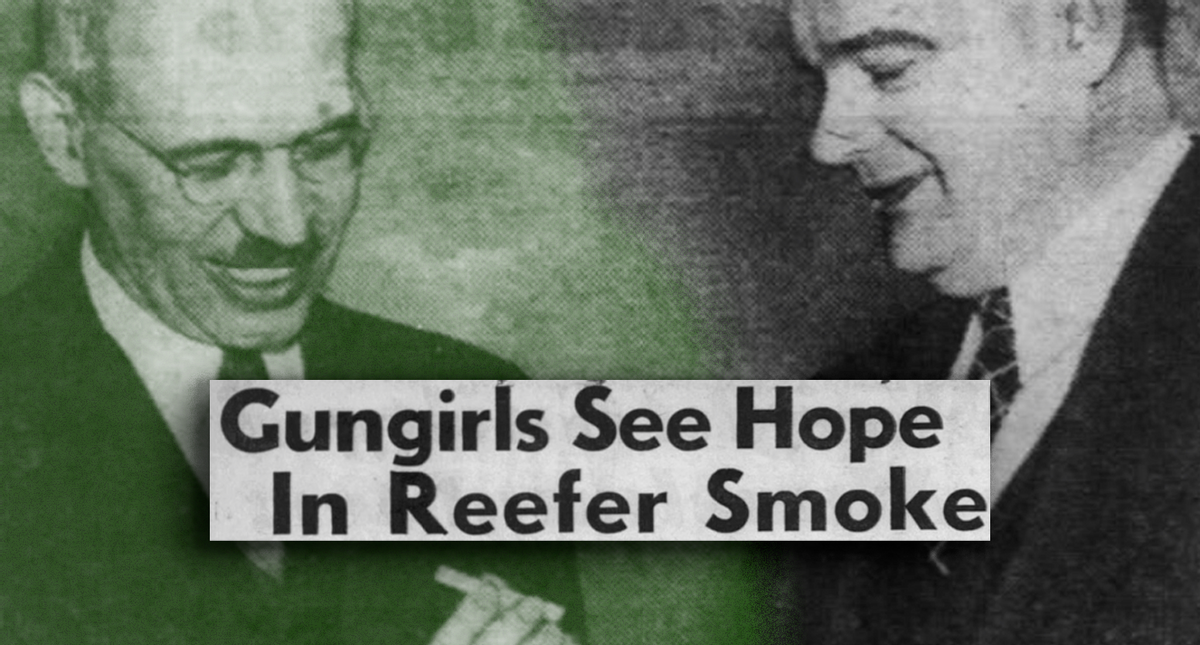James Munch was a toxicologist who served as an advisor to the U.S. Bureau of Narcotics on marijuana issues, though he was not "the official expert" for the federal government, as claimed in some sources. He was also an expert witness at murder trials involving defendants who committed crimes while high on marijuana. In several murder trials, he told, broadly, the same story about the only time he smoked marijuana. While it is a colorful tale involving flight and falling into a 200-foot deep inkwell, there is no evidence this story ever contained an assertion regarding Munch turning into a bat.
A popular reddit post in the r/todayilearned subreddit asserts that "James C. Munch testified in court, under oath, that he had smoked marijuana, and it turned him into a bat. Dr. Munch was the 'official expert' on marijuana for the U.S. government from 1938 to 1962."
James C. Munch was indeed used by both the government and private clients as an expert on marijuana issues in that time period, and he is on record as saying many colorful things about the one time he smoked marijuana in 1921, but it is possible the bat quote, specifically, was an accidental invention.
The primary source of this claim appears to be a speech on the "History of the Marijuana Laws" given by USC Law School Professor Charles Whitebread at a 1995 California Judges Conference. As reproduced on the website of the Schaffer Library of Drug Policy, Whitebread stated:
[I]n the late 30s and early 40s, in five really flamboyant murder trials, the defendant's sole defense was that he — or, in the most famous of them, she — was not guilty by reason of insanity for having used marijuana prior to the commission of the crime. [...]
In the most famous of these trials, what happened was two women jumped on a Newark, New Jersey bus and shot and killed and robbed the bus driver. They put on the marijuana insanity defense.
The defense called the pharmacologist, and of course, you know how to do this now, you put the expert on, you say "Doctor, did you do all of this experimentation and so on?" … "What have you done with the drug?" And he said … "I have used the drug myself."
What do you ask him next? "Doctor, when you used the drug, what happened?" With all the press present at this flamboyant murder trial in Newark New Jersey, in 1938, the pharmacologist said, and I quote, in response to the question "When you used the drug, what happened?", his exact response was: "After two puffs on a marijuana cigarette, I was turned into a bat."
He wasn't done yet. He testified that he flew around the room for fifteen minutes and then found himself at the bottom of a two-hundred-foot high inkwell. Well, friends, that sells a lot of papers. What do you think the Newark Star Ledger headline [was] the next day, October 12, 1938? "Killer Drug Turns Doctor to Bat!"
This same anecdote and alleged story is repeated in the 2007 book Cannabis: A History, by Martin Booth.
Snopes has found no contemporaneous reporting of any cases in which Munch testified that smoking weed made him think he was a bat. Such a finding is perplexing, because nearly every other aspect of the claim can be verified.
Munch Was an Expert on Marijuana for the Federal Government

Munch appeared in Congress as an expert witness during debates over the Marijuana Tax Act in 1937. In his appearance, he described his qualifications and resume up to that time:
I was for ten years connected with the Food and Drug Administration, during part of which time I was in charge of the pharmacology laboratory there. I am still a consulting pharmacologist for the Bureau of Biological Survey of the United States Department of Agriculture.
Following that appearance, in which he testified about the purported dangers of marijuana, he was invited to become a member of the advisory committee of what was then called the U.S. Bureau of Narcotics, run by Henry Anglisnger. He maintained an association with this group in some form until the 1960s. In this sense, it is fair to say he was considered a government expert on marijuana during this time.
Munch Described Getting High, Under Oath
In the 1930s, fears over marijuana leading to violence and crime rose in prominence. Munch was an instrumental player in the politicization of the drug, because he frequently offered "scientific" testimony to the effect that people under the influence of marijuana become violent and morally unhinged such that a temporary insanity plea could be a possible defense for murder.
The most famous murder case involving Munch as an expert witness was a February 1938 trial of two women accused of robbing and murdering a bus driver. One of them, Ethel "Bunny" Sohl, used the defense that she was not culpable because she had been high on marijuana at the time.

As reported by the New York Times, this defense was based largely on the expert testimony of Munch:
In carrying out the defense plea that Mrs. Sohl was a marijuana cigarette addict at the time the bus driver was slain, [defense attorney] Mr. McLaughlin had Dr. James C. Munch of Temple University testify. Dr. Munch said he had been retained by United State Government agencies in marijuana research work. In this work, he said, he had smoked a marijuana cigarette.
Munch gave a widely reported account of his own alleged experience with the drug, described here in the same New York Times story:
"I smoked the cigarette while sitting in a chair," he explained. "I had a dream. I dreamed that I had lived in an ink bottle for 200 years. Then I climbed to the neck of the bottle and wrote a book. Then I flew out of the bottle and flew around the world twice. Then I awakened. I had been asleep in the chair for sixteen minutes." Dr. Munch further testified that the general effect on marijuana addicts was that they have no conception of space or time.
While Sohl and her accomplice were both convicted of murder, the marijuana defense potentially contributed to their not being sentenced to death.
The anecdote told in the Sohl case sounds a whole lot like the story referenced in Professor Whitebread's 1995 speech in which Munch "testified that he flew around the room for fifteen minutes and then found himself at the bottom of a two-hundred-foot high inkwell." While that story does involve flying, it does not explicitly mention any bat. This is odd, given the large amount of print devoted by newspapers to all the other parts of this toxicologist's testimony.
Munch's basic testimony about smoking two marijuana cigarettes was widely reported on by a national collection of outlets, not only in the Sohl case, but also in other murder cases. Like any stoned tale, it hasn't been perfectly consistent — each telling (or retelling by journalists) is a bit different. But no reporting that Snopes has identified includes reference to a bat.
Here is how the New York Daily News described Munch's testimony during the Sohl trial:
Q. When did you start smoking marijuana cigarettes. Dr. Munch
A. In 1921. I only smoked two cigarettes.
Q. What effect did it have on you?
A. It made me think I got into an ink bottle and lived in it thousands of years (laughter).
Q. And when you came out of the ink bottle after nine thousand years you were still in your chair?
A. That's right. (laughter).
The amount of time spent in the ink bottle and from the time he smoked to the supposed dream vary from telling to telling. Here is how the New York Daily News quoted Munch's high, which lasted 16 minutes in the New York Time's initial reporting, a few months after the Sohl trial:
I seemed to have great blue wings and for a long time was flying round and round the world. I mean flying around the entire globe. I was scared to death when I finally got out of the ink bottle after 200 years, and looked at my watch. Exactly three minutes had elapsed from the time I took the last puff!
A Historical Game of 'Telephone'?
There is ample evidence that James C. Munch was a federal expert — at least on a consulting basis — about marijuana-related issues from the 1930s through the 1960s. There is, as well, ample evidence of him telling outlandish stories, under oath, about the one time he got high in 1922. This same basic story had been quoted or misquoted, excerpted, paraphrased, and rehashed many times and shaped by a media environment increasingly receptive to stories about the evils of marijuana.
The testimony, according only to contemporaneous reporting, certainly involved an ink bottle and flight, but no such reporting that Snopes has identified explicitly mentions bats. Is it possible the only preserved reporting comes from reporters who felt the bat detail superfluous? Yes. But it is also possible that the detail was added by USC Law Professor Whitebread in his 1995 speech as an imprecise paraphrase of these earlier reports.
In that speech, Whitebread made it clear he was referencing the Sohl bus driver murder:
Two women jumped on a Newark, New Jersey bus and shot and killed and robbed the bus driver. They put on the marijuana insanity defense. The defense called the pharmacologist [James C. Munch].
He also stated that coverage of Munch's testimony released "the next day" occurred on Oct. 12 1938:
What do you think the Newark Star Ledger headline [was] the next day, October 12, 1938? "Killer Drug Turns Doctor to Bat!"
Snopes has not identified this article. Outside of the reference to a bat, its existence would be perplexing for at least two reasons.
First, Munch's testimony in the Sohl case occurred on Feb. 11 and Feb 12, 1938, and received the most coverage on Feb 12 and Feb 13 of that year, based on a keyword scan of historical newspapers in Newspapers.com. Second, the Newark Star Ledger did not exist by that name at that time. That name formed from a merger of multiple newspaper conglomerates a year later, in 1939.
These inconsistencies suggest potential imprecision in how Whitebread relayed the specific details of Munch's testimony to his audience — a tale that already had some variability sewn into it over the years. As Whitebread's 1995 reference to Munch's being turned "into a bat" is the first such reference to this part of the story that we can identify, we consider the claim "Unproven" at this time.

